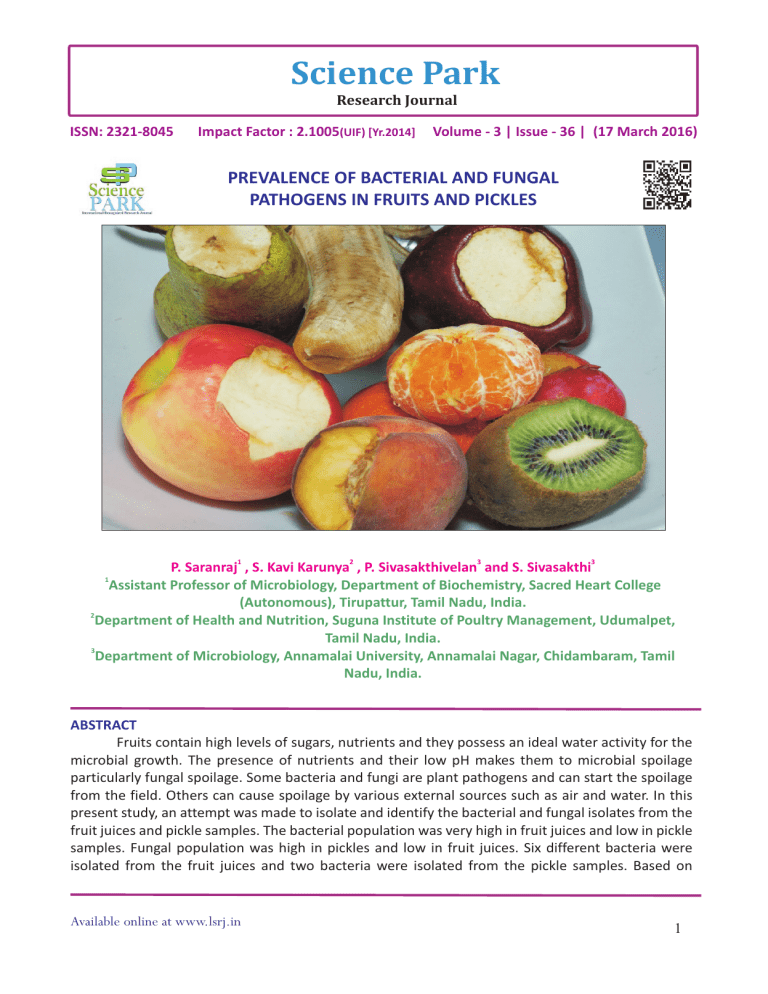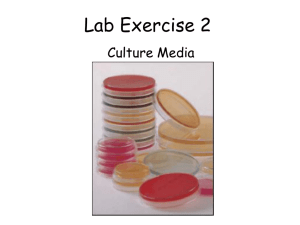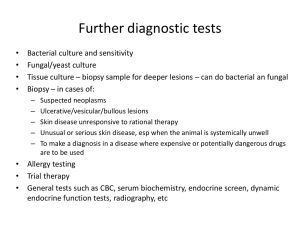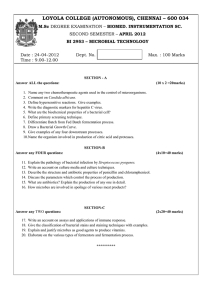Saranraj95
advertisement

Science Park Research Journal ISSN: 2321-8045 Impact Factor : 2.1005(UIF) [Yr.2014] Volume - 3 | Issue - 36 | (17 March 2016) PREVALENCE OF BACTERIAL AND FUNGAL PATHOGENS IN FRUITS AND PICKLES 1 2 3 3 P. Saranraj , S. Kavi Karunya , P. Sivasakthivelan and S. Sivasakthi 1 Assistant Professor of Microbiology, Department of Biochemistry, Sacred Heart College (Autonomous), Tirupattur, Tamil Nadu, India. 2 Department of Health and Nutrition, Suguna Institute of Poultry Management, Udumalpet, Tamil Nadu, India. 3 Department of Microbiology, Annamalai University, Annamalai Nagar, Chidambaram, Tamil Nadu, India. ABSTRACT Fruits contain high levels of sugars, nutrients and they possess an ideal water activity for the microbial growth. The presence of nutrients and their low pH makes them to microbial spoilage particularly fungal spoilage. Some bacteria and fungi are plant pathogens and can start the spoilage from the field. Others can cause spoilage by various external sources such as air and water. In this present study, an attempt was made to isolate and identify the bacterial and fungal isolates from the fruit juices and pickle samples. The bacterial population was very high in fruit juices and low in pickle samples. Fungal population was high in pickles and low in fruit juices. Six different bacteria were isolated from the fruit juices and two bacteria were isolated from the pickle samples. Based on Available online at www.lsrj.in 1 PREVALENCE OF BACTERIAL AND FUNGAL PATHOGENS IN FRUITS AND PICKLES preliminary tests, plating on selective media and biochemical tests, the isolated bacterial colonies were identified as Pseudomonas aeruginosa, Salmonella typhi, Staphylococcus aureus, Escherichia coli and Klebsiella pneumoniae. Two different bacterial isolates were identified from the pickle samples viz., Bacillus cereus and Proteus mirabilis. Based on Lactophenol Cotton Blue Staining and Colony morphology on Sabouraud’s Dextrose Agar, the fungi from fruit juice was identified as Penicillium expansum. Three different fungi viz., Mucor racemosus, Fusarium oxysporum and Rhizopus stolonifer were isolated from the pickles samples. KEY WORDS: Fruit juice, Pickles, Spoilage, Bacteria and Fungi. 1. INTRODUCTION Fruits are vital to our health and well being, as they are furnished with essential vitamins, minerals, fibers and other health - promoting phytochemicals. Fresh fruits have an external toughness, may be water proof, wax - coated protective covering or skin that functions as barrier for entry of most plant pathogenic microbes. The skin, however, harbours a variety of microbes and so the normal microflora of fruits is varied and includes both bacteria and fungi (Hanklin and Lacy, 1992). The microbes are restrained to remain outside on fruit surface as long as the skins are healthy and intact. Any cuts or bruises that appear during the postharvest processing operations allow their entry to the less protected internal soft tissue. Acidic fruit juices have also been implicated in outbreaks of gastroenteritis. Unpasteurized apple cider and apple juice were associated with outbreaks of Salmonella typhimurium and Escherichia coli (Parish, 2000). The growth of filamentous fungi in foods and food products results in waste and is costly as well as sometimes hazardous. Many different fungal species can spoil food products or produce mycotoxins or both. Biocontrol, an alternative to synthetic fungicides, employs antagonistic microorganisms that protect fruits and vegetables from infection of the pathogens (Conway et al., 2000). In most preserved foods, microbial growth causes undesirable changes in the odor, colour, taste, texture, or appearance of the food. In most cases, ingredients of pickles act as carriers of microbial contaminants (Rhyall and Pentzer, 1974). The utilization of poor quality vegetables, fruits and spices also influences the spoilage intensity in the preserved food, particularly in the homemade pickles. Spices are often the source of high microbial numbers (Byran, 1974). 2. MATERIALS AND METHODS 2.1. Collection of samples The fruit juices and pickles samples were collected from the local shops of Chidambaram, Cuddalore district, Tamil Nadu, India for the isolation and identification of bacterial and fungal species. The collected samples were stored in the refrigerator for further microbial isolation. 2.2. Isolation of bacterial and fungal species The bacterial and fungal species were isolated by Serial dilution technique. One ml of fruit juices were aseptically transferred into 99 ml of sterile distilled water and one gram pickles were transferred -1 into 100 ml of sterile distilled water and shaked well. The dilutions were made into 10 and the samples were diluted upto 10-6. Pour plate technique was used to isolate bacterial and fungal isolates in Nutrient agar and Rose Bengal agar respectively. The inoculated plates were incubated at 37 °C for 24 hours (in Nutrient agar for bacteria) and room temperature for 3 days (in Rose Bengal agar for fungi). The bacterial and fungal species were enumerated by using Qubec colony counter and expressed as cfu/ml. The isolated colonies from Nutrient agar plates and Rose Bengal agar plates were sub-cultured into agar Available online at www.lsrj.in 2 PREVALENCE OF BACTERIAL AND FUNGAL PATHOGENS IN FRUITS AND PICKLES slants and stored at 4 °C for further identification. 2.3. Identification of bacterial and fungal isolates Identification of the different bacterial isolates was carried out by the routine bacteriological methods i.e., By the colony morphology, Preliminary tests like Gram staining, Capsule staining, Endospore staining, Motility, Plating on selective media and by performing biochemical tests. Identification of purified fungal cultures were characterized by their morphology, hyphal characteristics, presence or absence of asexual spores, arrangement of conidia and reproductive structures (Alexopoulos and Mims, 1979, Beisher, 1991) and by performing Lactophenol cotton blue mount. 3. RESULT AND DISCUSSION Microorganisms forms the part of the epiphytic flora of fruits and vegetables and many will be present at the time of consumption. The majority of bacteria found on the surface of plants is usually Gram negative and belong either to the Pseudomonas group or to the Enterobacteriaceae (Lund, 1992). Samples of spoiled mixed pickles in oil collected from several locations showed high water activity and pH, which is promising for fungal contamination (Khan et al., 2005). In this present study, the pathogenic bacteria and fungi were isolated from fruit juices and pickles collected from Chidambaram local shops. Six bacterial isolates and two fungal isolates were identified by Pour plate technique. The total bacterial and fungal population present in the fruit juices and pickles samples was estimated and the results were showed in Table-1. The bacterial population was very high in fruit juices and low in pickle samples. Fungal population was high in pickles and low in fruit juices. Staphylococcus aureus is a dangerous pathogen and one of the most common causative agents of hospital infections (nosocomial infections) in human beings. Surface of vegetables may be contaminated by this organism through human handling and other environmental factors and can be able to survive for several weeks (Erkan et al., 2008). Human skin and nasal cavity is the main reservoir of Staphylococcus sp. Contamination of food stuffs during distribution and handling may allow bacterial growth and subsequently production of toxins which may represent a potential risk to humans (Erkan et al., 2008). In addition, vegetables and fruits have low buffering capacity, since the use of small amount of acid also lowers the pH significantly which provide promising growth condition for spoilage fungi. Similarly, all the samples have aw 0.81 to 0.938 while aw should be less than 0.81 in order to preserve the oil pickles for a longer period (Bone, 1973). Six different bacteria were isolated from the fruit juices and two bacteria were isolated from the pickle samples. Based on preliminary tests, plating on selective media and biochemical tests, they were identified as Pseudomonas aeruginosa (Apple juice, Mango juice and Grape juice), Salmonella typhi (Apple juice, Pine apple juice and Orange juice), Staphylococcus aureus (Mango juice, Pine apple juice and Orange juice), Escherichia coli (Apple juice, Grape juice, Mango juice, Pine apple juice and Orange juice) and Klebsiella pneumoniae (Grape juice, Mango juice and Orange juice). Two different bacterial isolates were identified from the pickle samples viz., Bacillus cereus (Mango pickle and Lemon pickle) and Proteus mirabilis (Garlic pickle and Lemon pickle). The characteristics of the isolated bacterial isolates were given in the Table - 2 to Table - 8. Samples of spoiled mixed pickles in oil collected from several locations showed high water activity and pH, which is promising for fungal contamination. Various filamentous fungi viz., Aspergillus, Penicillium, Alternaria, Rhizopus and Mucor were isolated. These isolations were able to produced lipolytic enzymes, which are responsible for the spoilage and rancidity of oil pickles. The lipolytic activity exhibited by spoilage fungal strains of pickles varied in the order of Penicillium> Rhizopus > Available online at www.lsrj.in 3 PREVALENCE OF BACTERIAL AND FUNGAL PATHOGENS IN FRUITS AND PICKLES Aspergillus > Mucor (Khan et al., 2005). Generally, oil pickles containing fruits are spoiled by Penicillium italicum, Penicillium digitatum and Penicillium expansum. Berries are predominantly carriers of Botrytis cinerea and Mucor mucedo. When carrots, cabbage, cucumbers and peppers are in pickles, various species of Aspergillus, Rhizopus and Alternaria become dominant (Walbeck, 1973). In the present study, only one fungi was isolated from the fruit juices. Based on Lactophenol cotton blue staining and colony morphology on Sabouraud’s dextrose agar, it was identified as Penicillium expansum (Apple juice, Grape juice, Mango juice, Pine apple juice and Orange juice). Three different fungi were isolated from the pickles samples. They are Mucor racemosus (Mango pickle), Fusarium oxysporum (Lemon pickle) and Rhizopus stolonifer (Garlic pickle) (Table - 9). Table - 1: Total bacterial and fungal population present in fruit juices and pickle samples Sample Apple juice Grape juice Mango juice Pine apple juice Orange juice Mango pickles Lemon pickles Garlic pickles Fungal population (cfu/g) -3 10 10-4 18 16 17 14 20 13 16 14 11 17 25 22 23 19 21 17 Bacterial population (cfu/g) -5 10 10-6 29 26 31 25 30 24 33 26 30 27 18 15 15 12 14 10 Table - 2: Characteristics of Staphylococcus aureus Test Gram staining Endospore Motility Catalase Oxidase Nutrient agar MacConkey agar Glucose fermentation Mannitol fermentation Sucrose fermentation Dextrose fermentation Indole Methyl Red Test Voges Proskauer Test Citrate utilization Coagulase DNAase Mannitol salt agar TSI medium Urease Available online at www.lsrj.in Results Gram positive cocci, arranged in clusters. No spores present Non-motile Negative Negative Colonies are smooth and golden yellow Lactose fermenting colonies. Acid produced Acid produced Acid produced Acid produced Negative Negative Positive Positive Positive Positive Golden yellow colonies No reaction Negative 4 PREVALENCE OF BACTERIAL AND FUNGAL PATHOGENS IN FRUITS AND PICKLES Table - 3: Characteristics of Pseudomonas aeruginosa Test Gram staining Motility Catalase Oxidase Nutrient agar MacConkey agar Glucose fermentation Mannitol fermentation Dextrose fermentation Sucrose fermentation Indole Methyl Red Test Voges Proskauer Test Citrate utilization Urease TSI O-F test Casein hydrolysis Results Gram negative slender rods Actively motile Positive Positive Blue coloured diffusible pigment producing colonies Non-lactose fermenting colonies Not fermented Not fermented Not fermented Not fermented Negative Negative Negative Positive Positive Alkaline butt, alkaline slant. No H2S and No gas production Oxidative Positive Table - 4: Characteristics of Escherichia coli Test Gram staining Motility Catalase Oxidase Nutrient agar MacConkey agar EMB agar Glucose fermentation Lactose fermentation Sucrose fermentation Mannitol fermentation Indole Methyl Red Test Voges Proskauer Test Citrate utilization Urease TSI Available online at www.lsrj.in Results Gram negative straight rods Motile Positive Negative Circular, smooth and colourless colonies Smooth, gloosy and pink coloured lactose fermenting colonies Small colonies with greenish metallic sheen Acid and gas produced Acid gas produced Acid gas produced Acid gas produced Positive Positive Negative Negative Negative Acid butt, alkaline slant, No H2S and gas produced 5 PREVALENCE OF BACTERIAL AND FUNGAL PATHOGENS IN FRUITS AND PICKLES Table - 5: Characteristics of Salmonella typhi Test Gram staining Motility Catalase Oxidase Nutrient agar MacConkey agar SSA agar Glucose fermentation Lactose fermentation Sucrose fermentation Mannitol fermentation Indole Methyl Red Test Voges Proskauer Test Citrate utilization Urease TSI Results Gram negative rods Motile Positive Negative Circular, moist, smooth, translucent colonies Non lactose fermenting colonies Small black colonies Acid and gas produced Acid and gas produced Acid and gas produced Acid and gas produced Negative Positive Negative Positive Negative Acid butt, alkaline slant, H 2S and gas produced Table - 6: Characteristics of Klebsiella pneumoniae Test Gram staining Capsule staining Motility Catalase Oxidase Nutrient agar MacConkey agar Glucose fermentation Lactose fermentation Sucrose fermentation Mannitol fermentation Indole Methyl Red Test Voges Proskauer Test Citrate utilization Urease TSI Available online at www.lsrj.in Results Gram negative rods Capsules present Non-motile Positive Negative Large, greyish white, dome, shaped and mucoid colonies of varying degrees of stickiness. Pink coloured lactose fermenting colonies Acid and gas produced Acid produced Acid produced Acid produced Negative Negative Positive Positive Positive Acid butt, alkaline slant, No H2S and gas produced 6 PREVALENCE OF BACTERIAL AND FUNGAL PATHOGENS IN FRUITS AND PICKLES Table - 7: Characteristics of Proteus mirabilis Test Gram staining Motility Catalase Oxidase Nutrient agar MacConkey agar Glucose fermentation Mannitol fermentation Dextrose fermentation Sucrose fermentation Indole Methyl Red Test Voges Proskauer Test Citrate utilization Urease TSI Phenylalanine deaminase test Results Gram negative rods Motile Positive Negative Swarming motility characterized by its fishy odour Non-lactose fermenting colonies Acid and gas produced Not fermented Not fermented Not fermented Negative Negative Negative Positive Positive Acid butt, alkaline slant, H2S produced and gas producers Positive Table - 8: Characterization of Bacillus cereus Test Gram staining Endospore Motility Catalase Oxidase Nutrient agar MacConkey agar Glucose fermentation Mannitol fermentation Sucrose fermentation Dextrose fermentation Indole Methyl Red Test Voges Proskauer Test Citrate utilization O-F test Nitrate reduction Gelatin hydrolysis Starch hydrolysis Urease Available online at www.lsrj.in Results Gram positive, thick, short rods. Central spores present Non-motile Positive Negative Large, circular, white, adherent, colonies, with membranous growth Non-lactose fermenting colonies Acid produced Acid produced Not fermented Not fermented Negative Negative Positive Positive Positive Positive Positive Positive Negative 7 PREVALENCE OF BACTERIAL AND FUNGAL PATHOGENS IN FRUITS AND PICKLES Table – 9: Colony morphology of fungi isolated from fruit juices and pickles Microscopic examination Penicillium expansum Septate hyphae with branched or unbranched conidiophores which have secondary branches known as medulla. On the medulla flask shaped sterigmata are arranged that bear unbranched chains of round conidia. Entire structure forms a brush border. Mucor racemosus Sporangiophores are long, often branched and bear terminal round sporangia filled with spores. Hyphae are non-septate and no rhizoids. Fusarium oxysporum Conidiophores are short, single, lateral monophialides in the aerial mycelium, later arranged in densely branched clusters. Macroconidia fusiform, slightly curved, pointed at the tip, basal cells pedicellate. Macroconidia abundant, never in chains, mostly non-septate, ellipsoidal to cylindrical, straight or often curved. Chlamydospores terminal or interacalary, haline, smooth or rough walled. Rhizopus stolonifer Sporangiophores are long and usually branched. Sporangiophores originating just above rhizoids. Thick walled chlamydospores may form. Hyphae may appear distorted with swollen cell or compressed, twisted and folded-rhizoids are present. Colony morphology on SDA plate Colony surface at first appears white then becoming powdery bluish green with a white border. Some species differ in gross appearance. Reverse side was white. Colonies quickly covers the agar surface with white fluffy mycelia but later turns grey, reverse side is white. Colonies grow rapidly; aerial mycelium white, usually becoming purple; discrete, erumpent, orange sporodochia are present in some strains; reverse hyaline to dark blue or dark purple. Colonies are usually white to cream to gray – pigmented. 5. CONCLUSION From this present study, it was concluded that the fruit juices and pickle samples collected from local shops harbor the pathogenic bacteria (Pseudomonas aeruginosa, Pseudomonas fluorescence, Salmonella typhi, Staphylococcus aureus and Escherichia coli, Klebsiella pneumoniae, Bacillus cereus and Proteus mirabilis) and fungi (Penicillium chrysogenum, Mucor racemosus, Fusarium oxysporum and Rhizopus stolonifer) which cause harmful diseases to human beings. It is must to prevent the spread of disease causing microorganisms from fruit juices and pickle samples. 6. REFERENCES 1)Alexopoulos, C. J and C. W. Mims. 1979. Introductory Mycology. John Wiley and Sons. pp: 1 - 613. 2)Beisher, L. 1991. Microbiology in Practice. A self Instructional Laboratory Course. New York: Ed Harper Collins Publisher, pp: 65. 3)Bone, D. 1973. Water activity in intermediate moisture foods. Food Technology, 16: 177 – 178. 4)Byran, F. L. 1974. Microbial food hazards, today based on epidemiological information. Food Technology 28: 52 – 66. 5)Conway, W. S., B. Leverentz, R. A. Saftner, W. J. Janisiewicz, C. E. Sams and E. Leblanc. 2000. Survival and growth of Listeria monocytogenes on fresh cut apple slices and its interaction with Glomerella Available online at www.lsrj.in 8 PREVALENCE OF BACTERIAL AND FUNGAL PATHOGENS IN FRUITS AND PICKLES cingulata and Penicillium expansum. Plant Diseases, 84: 177 – 181. 6)Erkan, M., S. Y. Wang and C. Y. Wang. 2008. Effect of UV treatment on antioxidant capacity, antioxidant enzyme activity and decay in strawberry fruit. Postharvest Biology and Technology, 48: 163 - 171. 7)Hanklin, L and G. H. Lacy. 1992. Pectinolytic microorganisms. In: Compendium of Methods for the Microbiological Examination of Foods, Vanderzant C, Splittstoesser DF (eds.), American Public Health Assoc., Washington DC, pp.176 – 183. 8)Khan, S. H., Faquir Muhammad, M. Saffiq and Imthiaz Hussain. 2005. Some studies on spoilage fungi in pickles. Journal of Agriculture and Social Science, 1: 14 - 15. 9)Lund, B. M. 1992. Ecosystems in vegetable foods. Journal of Applied Bacteriology, 73 (21): 115 - 135. 10)Parish, M. 2000. Relevancy of Salmonella and pathogenic E. coli to fruit juices. Fruit Processing, 7: 246 - 250. 11)Rhyall, A. L and W. T. Pentizer. 1974. Handling Transportation and Storage of Fruits and Vegetables. AVI Publications Co. Inc. Westport Connecticut, USA. 12)Walbeck, Y. W. 1973. Fungal toxins in food. Canadian Food Technology, 6: 96 – 100. P. Saranraj Assistant Professor of Microbiology, Department of Biochemistry, Sacred Heart College (Autonomous), Tirupattur, Tamil Nadu, India. Available online at www.lsrj.in 9



